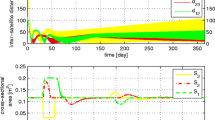Abstract
Because of their volume and power limitation, it is difficult for CubeSats to configure a traditional propulsion system. Atmospheric drag is one of the space environmental forces that low-orbit satellites can use to realize orbit adjustment. This paper presents an integrated control strategy to achieve the desired in-track formation through the atmospheric drag difference, which will be used on ZJUCubeSat, the next pico-satellite of Zhejiang University and one of the participants of the international QB50 project. The primary mission of the QB50 project is to explore the near-Earth thermosphere and ionosphere at the orbital height of 90–300 km. Atmospheric drag cannot be ignored and has a major impact on both attitude and orbit of the satellite at this low orbital height. We conduct aerodynamics analysis and design a multidimensional nonlinear constraint programming (MNLP) strategy to calculate different desired area–mass ratios and corresponding hold times for orbit adjustment, taking both the semimajor axis and eccentricity into account. In addition, area–mass ratio adjustment is achieved by pitch attitude maneuver without any deployable mechanism or corresponding control. Numerical simulation based on ZJUCubeSat verifies the feasibility and advantage of this design.
Similar content being viewed by others
References
Bazaraa, M.S., Sherali, H.D., Shetty, C.M., 2013. Nonlinear Programming: Theory and Algorithms. John Wiley & Sons, New Jersey.
Byrd, R.H., Hribar, M.E., Nocedal, J., 1999. An interior point algorithm for large-scale nonlinear programming. SIAM J. Optim., 9(4): 877–900. https://doi.org/10.1137/S1052623497325107
Cai, B., Wang, H., Zhu, X., et al., 2011. Design of the Earth magnetic field measurement system for pico-satellites. Chin. J. Sens. Actuat., 27(8): 1–5 (in Chinese). https://doi.org/10.3969/j.issn.1004-1699.2011.08.026
Campbell, M., Fullmer, R.R., Hall, C.D., 2000. The ION-F formation flying experiments. AAS/AIAA Space Flight Mechanics Meeting, p.135–149. https://doi.org/10.13140/2.1.3903.3603
Drob, D., Emmert, J., Crowley, G., et al., 2008. An empirical model of the Earth’s horizontal wind fields: HWM07. J. Geophys. Res. Space Phys., 113:A12304. https://doi.org/10.1029/2008JA013668
Eyer, J.K., Damaren, C.J., Zee, R.E., et al., 2007. A formation flying control algorithm for the CanX-4&5 low Earth orbit nanosatellite mission. Space Technol., 27(4): 147–158.
Gaposchkin, E.M., 1994. Calculation of Satellite Drag Coef-ficients. Technical Report, DTIC Document.
Horsley, M., Nikolaev, S., Pertica, A., 2013. Small satellite rendezvous using differential lift and drag. J. Guid. Contr. Dynam., 36(2): 445–453. https://doi.org/10.2514/1.57327
Lambert, C., Kumar, B.S., Hamel, J.F., et al., 2012. Imple-mentation and performance of formation flying using differential drag. Acta Astronaut., 71: 68–82. https://doi.org/10.1016/j.actaastro.2011.08.013
Leonard, C.L., Hollister, W.M., Bergmann, E.V., 1989. Orbital formationkeeping with differential drag. J. Guid. Contr. Dynam., 12(1): 108–113. https://doi.org/10.2514/3.20374
Liu, L., 2000. Orbit Theory of Spacecraft. National Defense Industry Press, Beijing, p.86–90 (in Chinese).
Lohn, J.D., Hornby, G.S., Linden, D.S., 2005. An evolved antenna for deployment on NASA’s Space Technology 5 Mission. In: O’Reilly, U.M., Yu, T., Riolo, R., et al. (Eds.), Genetic Programming Theory and Practice II. Springer, New York, p.301–315. https://doi.org/10.1007/0-387-23254-0_18
Marcos, F.A., 2006. New satellite drag modeling capabilities. 44th AIAA Aerospace Sciences Meeting and Exhibit, p.1–13. https://doi.org/10.2514/6.2006-470
Meng, T., Wang, H., Jin, Z.H., et al., 2009. Attitude stabiliza-tion of a pico-satellite by momentum wheel and magnetic coils. J. Zhejiang Univ.-Sci. A, 10(11): 1617–1623. https://doi.org/10.1631/jzus.A0820425
Moe, K., Moe, M.M., 2005. Gas–surface interactions and satellite drag coefficients. Planet. Space Sci., 53(8): 793–801. https://doi.org/10.1016/j.pss.2005.03.005
Montenbruck, O., Gill, E., 2012. Satellite Orbits: Models, Methods and Applications. Springer Science & Business Media.
Pérez, D., Bevilacqua, R., 2013. Differential drag spacecraft rendezvous using an adaptive Lyapunov control strategy. Acta Astronaut., 83: 196–207. https://doi.org/10.1016/j.actaastro.2012.09.005
Picone, J.M., Hedin, A.E., Drob, D.P., et al., 2002. NRLMSISE-00 empirical model of the atmosphere: sta-tistical comparisons and scientific issues. J. Geophys. Res. Space Phys., 107(A12): SIA15-1-SIA15-16. https://doi.org/10.1029/2002JA009430
Reid, T., Misra, A.K., 2011. Formation flight of satellites in the presence of atmospheric drag. J. Aerosp. Eng. Sci. Appl., 3(1): 64–91.
Reinhard, R., Asma, C., Muylaert, J., 2012. The QB50 project: a Network of 50 Cubesats. Von Karman Institute for Fluid Dynamics, Rhode Saint Genese, Belgium.
Schamberg, R., 1959. A New Analytic Representation of Sur-face Interaction for Hyperthermal Free Molecule Flow with Application to Neutral-Particle Drag Estimates of Satellites. Rand Corporation.
Schaub, H., Alfriend, K.T., 2002. Hybrid Cartesian and orbit element feedback law for formation flying spacecraft. J. Guid. Contr. Dynam., 25(2): 387–393. https://doi.org/10.2514/2.4893
Vallado, D.A., 2001. Fundamentals of Astrodynamics and Applications. Springer Science & Business Media, Berlin.
Vallado, D.A., Finkleman, D., 2014. A critical assessment of satellite drag and atmospheric density modeling. Acta Astronaut., 95: 141–165. https://doi.org/10.1016/j.actaastro.2013.10.005
Varma, S., Kumar, K.D., 2012. Multiple satellite formation flying using differential aerodynamic drag. J. Spacecr. Rock., 49(2): 325–336. https://doi.org/10.2514/1.52395
Wang, J., Wang, H., Ying, P., et al., 2012. Design of four-quadrant analog Sun sensor. Chin. J. Sens. Actuat., 25(12): 1659–1663 (in Chinese). https://doi.org/10.3969/j.issn.1004-1699.2012.12.007
Yang, M., Wang, H., Wu, C.J., et al., 2012. Space flight vali-dation of design and engineering of the ZDPS-1A pico-satellite. Chin. J. Aeronaut., 25(5): 725–738. https://doi.org/10.1016/S1000-9361(11)60439-1
Yao, H., Zeng, G.Q., Hu, M., 2010. Time-optimal aerodynamic control for along-track separation of spacecraft formation flying. J. Acad. Equip. Comm. Technol., 21(1): 70–73 (in Chinese). https://doi.org/10.3783/j.issn.1673-0127.2010.01.017
Author information
Authors and Affiliations
Corresponding author
Additional information
Project supported by the National Science Fund for Distinguished Young Scholars of China (No. 61525403) and the National Natural Science Foundation of China (No. 61503334)
Rights and permissions
About this article
Cite this article
Deng, Sc., Meng, T. & Jin, Zh. Nonlinear programming control using differential aerodynamic drag for CubeSat formation flying. Frontiers Inf Technol Electronic Eng 18, 867–881 (2017). https://doi.org/10.1631/FITEE.1500493
Received:
Accepted:
Published:
Issue Date:
DOI: https://doi.org/10.1631/FITEE.1500493




